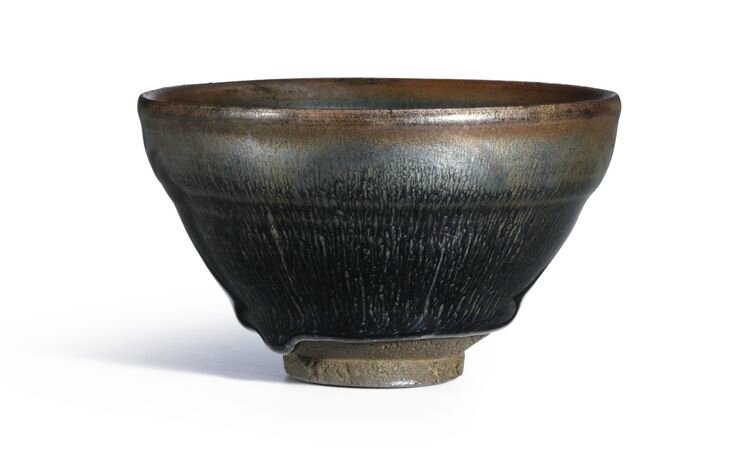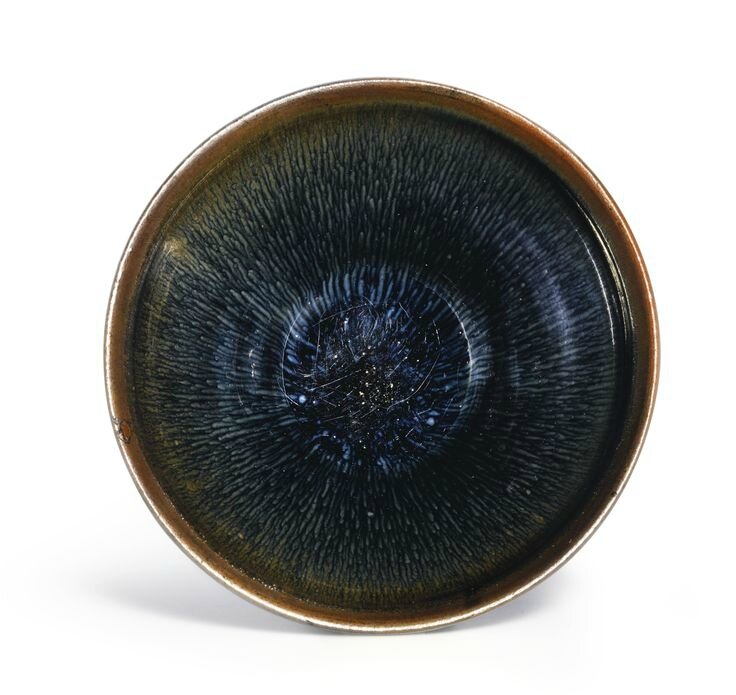A rare 'Jian' 'Hare's fur' 'Temmoku' tea bowl, Southern Song Dynasty
A rare 'Jian' 'Hare's fur' 'Temmoku' tea bowl, Southern Song Dynasty. Estimate 2,500,000 — 3,500,000 HKD. Lot sold 3,080,000 HKD. Photo courtesy Sotheby's
well potted, the conical sides rising from a short foot to a lip bordered with a thin concave groove, unctuously covered with a lustrous black glaze with iridescent silvery-blue striations, the glaze draining from the rim and stopping well above the foot in a glossy black bulge revealing the dark brown body beneath; 12 cm., 4 3/4 in.
Provenance: Collection of Baron Denzaburo Fujita (1841-1912).
Note: 'Hare's fur' glazes of this radiant type, which have been passed from hand to hand over the centuries in Japan, are exceedingly rare. The humble appearances of these tea bowls made them appropriate for use in Buddhist temples, and they were held in great esteem in the Song dynasty (960-1279). Dramatically contrasting to the white foam of whipped tea, bowls enveloped in this lustrous black glaze were greatly appreciated and soon gained popularity beyond the monastic circles. Emperor Huizong (r. 1101-25), well known for his love for tea, stated that the black-glazed tea bowls, especially those decorated with 'hare's fur' like the present example, were the most desirable. Together with whipped tea, Song dynasty 'Jian' tea bowls are believed to have arrived in Japan in the Kamakura period (1185-1333) when Zen Buddhism was introduced, and have since then been greatly treasured.
A similar bowl was included in the exhibition Karamono temmoku [Chinese temmoku], MOA Art Museum, Atami, 1994, cat. no. 6. This exhibition catalogue, where a few important heirloom temmoku tea bowls preserved in Japan were juxtaposed with a large sample of excavated specimens from the kiln site, impressively documented the wide range of qualities and the excellence of the examples collected in Japan. Another bowl with a similar glaze appearance in the Metropolitan Museum of Art, New York, was included in the exhibition Hare's Fur, Tortoiseshell, and Partridge Feathers. Chinese Brown- and Black-Glazed Ceramics, 400-1400, Harvard University Art Museums, Cambridge, Mass., 1996, cat. no. 83. Only one sherd with a similar glaze effect is illustrated in J.M. Plumer, Temmoku. A Study of the Ware of Chien, Tokyo, 1972, p. 59, pl. 8
Sotheby's. Contemporary Literati: Curiosity, Hong Kong, 05 avr. 2015

/https%3A%2F%2Fprofilepics.canalblog.com%2Fprofilepics%2F1%2F0%2F100183.jpg)
/https%3A%2F%2Fstorage.canalblog.com%2F03%2F02%2F119589%2F96711876_o.jpg)
/https%3A%2F%2Fstorage.canalblog.com%2F11%2F31%2F119589%2F94773502_o.jpg)
/https%3A%2F%2Fstorage.canalblog.com%2F20%2F83%2F119589%2F94772815_o.jpg)
/https%3A%2F%2Fstorage.canalblog.com%2F26%2F72%2F119589%2F75604929_o.jpg)
/https%3A%2F%2Fstorage.canalblog.com%2F59%2F60%2F119589%2F26458628_o.jpg)




/http%3A%2F%2Fstorage.canalblog.com%2F76%2F98%2F119589%2F129048212_o.png)
/http%3A%2F%2Fstorage.canalblog.com%2F13%2F75%2F119589%2F129042229_o.png)
/http%3A%2F%2Fstorage.canalblog.com%2F02%2F43%2F119589%2F126917236_o.jpg)
/http%3A%2F%2Fstorage.canalblog.com%2F38%2F46%2F119589%2F126901696_o.jpg)